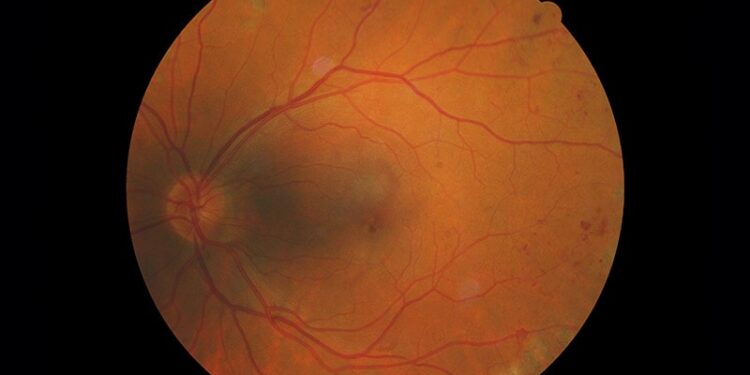High levels of the protein interleukin 6 (IL-6) in the aqueous fluid of the eye may be a powerful biomarker for evaluating the severity of diabetic eye disease and could help identify patients at the highest risk for disease progression, researchers have found.
The prospective, single-center study, conducted at the Vanderbilt Eye Institute in Nashville, Tennessee, included 328 eyes of 164 people with diabetes, of whom 23 did not have diabetic retinopathy, 118 had moderate nonproliferative retinopathy, and 23 had proliferative retinopathy, a more severe form of the disease. Eyes without retinopathy had lower levels of IL-6 collected in the aqueous fluid than those with the condition.
A Potential Biomarker
“IL-6 is potentially a biomarker of diabetic eye disease severity and it’s a novel target for therapy,” said Stephen J. Kim, MD, chief of the Retina Division at Vanderbilt Eye Institute. “We can start focusing on inhibiting IL-6; that’s the breakthrough, that we now have an inflammatory cytokine that we can use to follow disease, that correlates with disease severity, and we can now inhibit it.”

Kim and his colleagues published the results of the study, called INSPIRE, on June 27 in Ophthalmology Retina.
The study found that the median level of IL-6 was 5.4 pg/mL (2.99-877) in eyes with no retinopathy, 9.25 pg/mL (5.35-22.35) in eyes with moderate nonproliferative retinopathy, and 15.71 pg/mL (9.24-45.58) in eyes with proliferative disease (P < .001).
The study also found no difference in median A1c between the three groups (P = .03). “There was no correlation between IL-6 and A1c in our study, and that’s not surprising because A1c does not correlate very well with risk of progression in diabetic eye disease,” Kim said.
Previous studies implicating IL-6 in diabetic eye disease were small, retrospective studies in which the role of IL-6 was a secondary finding. INSPIRE claims to be the largest analysis of aqueous IL-6 in diabetic eyes.
“The value of this study is that this was a prospective, rigorously assessed, meticulous study,” he said.
A limitation of the study is that it makes two assumptions, Kim said: Aqueous levels of IL-6 are commensurate with levels produced in retina, acting as a surrogate marker; and the study’s cross-sectional nature. “We’re not showing a cause and effect that IL-6 levels caused diabetic retinopathy or diabetic macular edema,” Kim said. “We’re just showing a very strong relationships between the two that’s suggestive of cause and effect.”
INSPIRE is a 3-year study, and the opportunity exists to demonstrate cause and effect, Kim said.
The finding is “very practical” because four IL-6 inhibitors are commercially available in the US: tocilizumab (Actemra), indicated for rheumatoid arthritis (RA) and other diseases; sarilumab (Kevzara) for RA; siltuximab (Sylvant) for HIV; and satralizumab (Enspryng) for neuromyelitis optical spectrum disorder. “This can translate very rapidly,” Kim said.
“This is a potential new treatment to a huge unmet need, and IL-6 may also be a biomarker that we can use to follow not only someone’s disease severity but to predict how they will do in 12 months or 24 months,” Kim added.
‘Pioneering’ Step
Thomas W. Gardner, MD, MS, a professor of ophthalmology and internal medicine at the Kellogg Eye Center at the University of Michigan in Ann Arbor, Michigan, said other studies have shown elevated inflammatory markers in the vitreous or aqueous fluid in both human and experimental models. “What has been lacking is a prospective, longitudinal study using human samples and correlating those findings with the disease state,” he said. “This study is important in being pioneering in that step.”

Genentech, a subsidiary of Roche, is developing an IL-6 inhibitor, vamikibart, for ophthalmic use, he noted.
While obtaining aqueous fluid from the eye can be “easy and safe,” Gardner said, handling and processing the samples is fraught with uncertainty. “How individual ophthalmologists would have those samples analyzed is something that has to be established,” he said. “But that’s a minor issue.”
Gardner called INSPIRE “a big first step. It isn’t necessarily an answer, but it is important for the proof of principal underlying being able to faithfully analyze a molecule such as IL-6 and to incentivize more studies of this type.”
The study was funded by the National Institutes of Health. Kim reported having no relevant financial relationships. Gardner reported having financial relationships with OcularDX and BioCryst.
Richard Mark Kirkner is a medical journalist based in Philadelphia.
Source link : https://www.medscape.com/viewarticle/study-finds-elevated-levels-interleukin-6-eyes-diabetic-eye-2025a1000is8?src=rss
Author :
Publish date : 2025-07-16 12:38:00
Copyright for syndicated content belongs to the linked Source.













